Shuttle AV40
|
Introduction 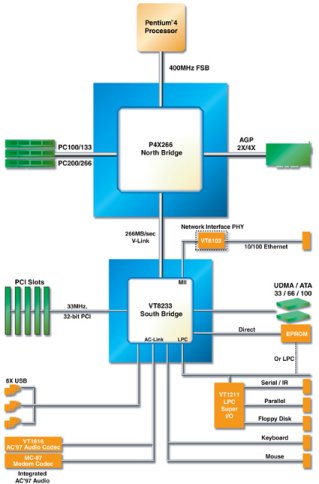 As we can see, the P4 interfaces with the northbridge via a 400Mhz (100Mhz QDR) front side bus and the northbridge takes care of the memory interface and the AGP interface. The memory interface supports PC100/133 SDR SDRAM and also the DDR interface supporting PC200/266 (PC1600/2100) DDR SDRAM which will feature on the majority indeed if not all P4X266 boards. The AGP interface supports 1.5V cards only and 2x/4x speeds with fast writes. The south bridge is linked to the north bridge by VIDA's 266Mb/sec V-Link bus and handles everything else that the northbridge doesn't including the PCI interface, UDMA controller, I/O (Serial, Parallel, IR, Floppy), PS2 ports, 6 USB ports and the AC'97 built in audio. There is also a 10/100 Ethernet controller interface that requires a seperate IC (VT6103) and isn't implemented on the AV40R. The P4X266 is also a V-MAP chipset and allows drop in support for updated revisions of the chipset and also other chipsets that VIA may produce that support the P4 processor. As we've seen from previous Pentium 4 based reviews, memory bandwidth is the key to fast Pentium 4 performance. Can the P4X266 with it's low latency but relatively low 2.1Gb/sec performance when using PC2100 memory be quick enough to match or surpass the i850/RAMBUS combination offering higher latency but 1.1Gb/sec more memory bandwidth at 3.2Gb/sec? So lets see how Shuttle do when implementing the P4X266 and see if it compares to the i845-D and i850 performance wise. Shuttle AV40R ChipsetAs we can see, there's nothing that stands out here except a Promise IDE RAID controller and the headers for on board sound. Everything else is standard fare on a performance motherboard. Layout and installation  Let's take a look at the layout of the AV40R. Startting at the top left we have the usual capacitors flanking the socket enclosure on the left edge and the socket enclosure itself. Carrying on to the right of the socket enclosure we hit the ATX connector running horizontally along the top edge of the board. Directly underneath the connector we have the 3 DDR DIMM slots, thankfully not too close to the ATX connector so as to make operating the tabs on the slots a pain. Normally at this point when discussing the layout I'd hopefully be telling you how the IDE and floppy ports are high up and vertically alligned along the far vertical edge of the board and parallel to the memory slots. However this couldn't be further from the case on the Shuttle. The two main IDE ports lie underneath the memory slots on the far right edge, vertically aligned. The RAID ports are horizontally aligned and right along the bottom edge of the board, stacked up and in the right hand corner. That's a non optimal layout for starters but the floppy drive connector placement takes some beating. Tucked up under the last PCI slot and half way along the bottom edge of the board, the floppy connector couldn't be in a worse place. It means requiring a longer cable depending on the case being used and also if you have a card in PCI5 it will mean having to twist the cable past the card edges. For my case at least, a nightmare placement for the floppy cable and not so great on the IDE connectors either. The rest of the layout is sane and standard with the extra P4 power connectors placed near the bottom left corner of the socket enclosure and the ATX case headers in the usual bottom right spot. Installation was fine apart from the need to liberate an extra long floppy cable from another machine. It's a 9 hole ATX mount so it's not as slimline as some recent P4 boards we've seen but it's not a problem as long as your case has no problem accepting a full size ATX motherboard. BIOS, Manual and Bundle The BIOS is your usual AWARD fare with CPU adjustment (including multiplier if you are lucky enough to own an unlocked engineering sample processor) and you have voltage adjustment up to 1.85V and DDR volt adjust to 2.7V. You also have decent control over your DDR timings on the Shuttle and you can set things like bank interleaving, CAS, Tras and memory frequency. The only thing missing from the BIOS (and the board for that matter in the form of a jumper) was the ability to disable the Promise RAID controller. It's nice to have the feature and maybe you can argue that if you didn't need the controller you wouldn't buy the R version and would have picked up the AV40 instead, but it's nice to be able to turn it off if you don't use it. It slows the boot process checking for drives. Hopefully that can be remedied in a later BIOS. The manual is well translated and easy to read and it was easy to pick out the information I needed when setting the board up and also locating the diagram for the ATX case headers. The bundle is standard and you get the board, driver CD, USB backplane and the standard compliment of IDE cables and a floppy cable. Performance Again, like the MSI 845 Ultra ARU review, it would have been nice to use the same 2GHz ES processor that featured in our i845 reviews recently but alas it wasn't available so we've used the same retail 1.7 used in the MSI review. Test SystemThe version of Sandra used here is the beta version that doesn't use prefetch and buffering on Pentium 4 processors like we used on the MSI. The benchmarks on the Shuttle were taken before we got our hands on that latest version of Sandra. Performance at 1.7Ghz (17 x 100) Sandra numbers first as usual. Sandra CPU Arithmetic Benchmark 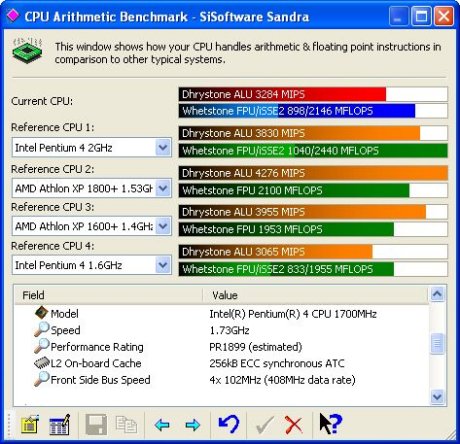 Sandra CPU Multi-Media Benchmark 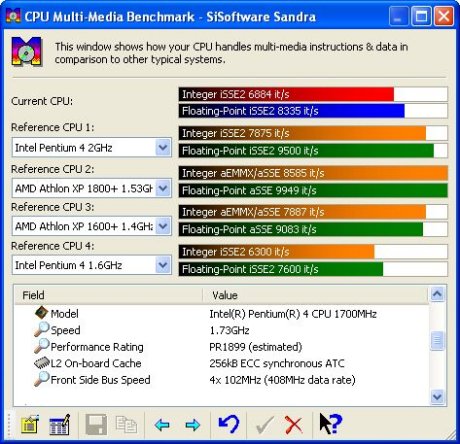 Sandra Memory Bandwidth Benchmark 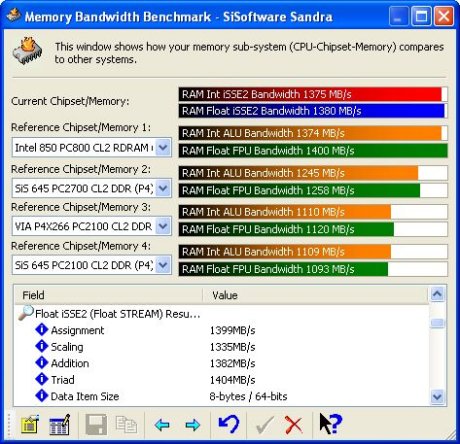 Here we can see that the processor is allowed to work to it's full potential by the host chipset and the memory controller is functioning better than Sandra expects. It's 200Mb/sec more than the reference numbers that Sandra provides and faster than the SiS645 in PC333 mode. While they are only theoretical benchmarks they give us a good indication that things are working well. Glaring inefficiencies in the memory controller settings for example can be easily spotted just by a quick glance at a Sandra graph, one of the strengths of Sandra when examining hardware. We use POVRay to double check that things are OK on the CPU front. It's a good CPU stress tester, especially under Window 2000 or XP when 99% of problems with POVRay when running at overclocked speeds are caught by the operating system and handled gracefully unlike some other programs that will blue screen or hang the operating system when pushing the processor too hard. Being a P4 based system we can run both P3 binary which happily runs on any x86 processor and the P4 binary that only executes on a Pentium 4 processor and highlights the speedups you can gain from simple compiler optimisation for the processor. P3 Binary  P4 Binary  For comparison the 845 Ultra ARU scores 65s and 48s respectively so the 65s and 47s from the Shuttle are spot on. Everthing is running well as far as the processor is concerned on the Shuttle. The host chipset lets the CPU perform as it should. Finally at out stock speed of 1700Mhz we have 3DMark 2001 Professional. 3DMark is our system benchmark that stresses the whole system from CPU clock to Front Side Bus speed to graphics cards clocks and everything in between. We can't make a direct comparison to the 845 Ultra here since we were running the MSI Ti500 in that review and we are only running a stock clocked GeForce3 (200/460 compared to 240/500). However we can estimate the score of the Shuttle if it were to be running with a Ti500 installed.  We are 424 points down on the 845 Ultra due to the slower clocks of the stock GeForce3. However the Ti500 gives a score advantage of around 500 points so we can estimate that the board would actually be faster than the 845 Ultra but still slightly behind a GF3 and i850/RAMBUS and a 1.7Ghz Pentium 4 processor. There is very little to choose between the P4X266 system and the i845-D. Stock untweaked performance out of the box is very impressive. 3DMark is giving us the 6000+ score that we use as an indicator to good DX8 class performance so the GF3, 1.7 P4 and P4X266 chipset are a good combination. The chipset is performance as expected and Shuttle have implemented it well it seems. Performance at 2Ghz (17 x 117) It turns out that while we could only manage 1.92Ghz stable on the MSI with the same range of CPU Vcore available, the Shuttle was able to go a little bit higher and manage a stable benchmark speed of just under 2Ghz at ~1993Mhz (17 x 117). All our review benchmarks were totally stable at that speed and general browing and using Windows XP was fine. 1.85V Vcore was needed for the overclock and the stock Intel retail cooler was used. First off, our Sandra numbers. Sandra CPU Arithmetic Benchmark 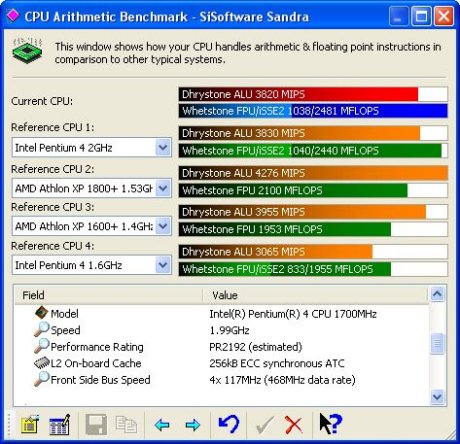 Sandra CPU Multimedia Benchmark 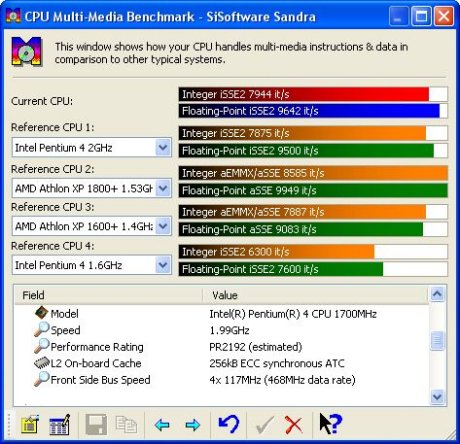 Sandra Memory Bandwidth Benchmark 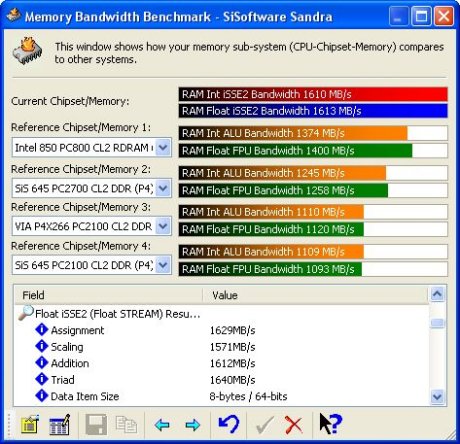 The CPU running at nearly 2Ghz gives us Sandra CPU benchmark number exactly where they should be. It matches the default Sandra numbers for the 2Ghz P4 almost exactly. The memory bandwidth benchmark shows the effect overclocking the frontside bus has on the memory speed on the P4X266. With the FSB running 17Mhz overspec, our single stick of Crucial memory is also running at 17Mhz over specification at 150Mhz. At 150Mhz the results from Sandra are most impressive and are better than any of the reference numbers. POVRay lets us confirm that the CPU is running correctly. P3 Binary  P4 Binary  The 1.92Ghz P4 in the MSI managed 53s and 43s respectively for our two test binaries so the extra clock speed available here when running at effectively 2Ghz on the Shuttle is good for a 3s lead over the MSI in each test. The results are exactly inline with what we expect from a 2GHz Pentium 4 processor. Finally, 3DMark 2001 which responds well to changes in front side bus speed and CPU speed so we should see a healthy increase in the score even tho the graphics clocks are static.  We get 500 points for free here from the 117Mhz FSB and 2Ghz CPU speed. The score eclipses the 7000 point mark without any difficulty and would get rather a lot higher when overclocking the card and tweaking the drivers. Most 1.7's are doing 2Ghz without much difficulty now at around the 117Mhz FSB mark and many even more. At 1.85V the performance is free and you'd be hard pushed to find peripherals these days that would complain about the increased bus speeds on the system. You also need a very poor stick of PC2100 to not be able to make 150Mhz at 2.7V Vdimm. So it's a nice, essentially free boost in performance over the stock speed. When you hit 2Ghz, the P4 starts to take off and Netburst really starts to show it's strength. Overall, overclocking on the Shuttle was easy and painless. Increase voltages and key in a new number into the BIOS and reboot. If you push it too far, reset CMOS and start from fresh. Overall So what do we think of the P4X266 compared to Intel's official DDR chipset and have Shuttle done the chipset justice? The chipset performs on a par with or even better than the i845-D. Performance of both chipsets is neck and neck in all our test areas. DDR memory is a good match for the P4 processor. Overall memory bandwidth is lower than i850 and PC800 RAMBUS but the latency is a lot lower so it tips the real world balance back towards DDR memory. Ultimately, i850 and PC800 wins the battle but maybe not for long. SiS and their 645 chipset support DDR333 memory offering 2.7Gb/sec which is closer to the 3.2Gb/sec theoretical maximum of PC800 RAMBUS memory. The chipset is a fine effort from VIA, even though it's currently surrounded by the angry Intel lawyers. Being a V-MAP chipset the recently released A revision of the chipset (P4X266A) slots right in and is pin compatible. Shuttle have recently released the AV45GT based on the new chipset which offers further performance boosts over the revision used in the AV40R on test today. So have Shuttle done the chipset justice? Apart from the glaring layout problems the board does very will. The onboard sound works well with only apparent playback problems under very high system loads which is to be expected. The performance was slightly higher than expected and the core features are fine. Nothing outstanding, just incredibly solid. I'd have enjoyed using the board a lot more if the layout problems weren't there and the RAID controller could have been turned off. They spoil things somewhat which is a shame. Shuttle is another brand with low exposure in the UK and we hope that changes. More competition is always a good thing. A quick hunt on Pricewatch shows that non of Pricewatches listed retailers carry the AV40R so it might be a struggle finding this board. Hopefully the Shuttle guys can get their boards out to a good distributor. Hopefully we'll see other Shuttle products at Hexus in the future including the excellent SV24 system.
|













